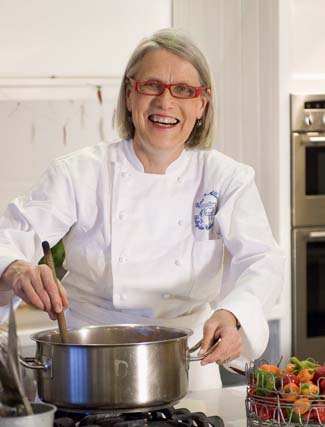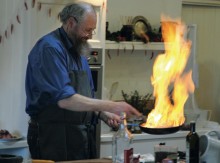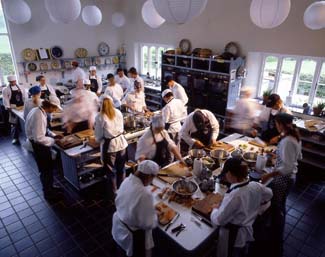The Darina Allen Column - Game
 Game is a treat at this time of year, but what do you do with it if you’re lucky enough to receive some as a gift? Together with expert George Gossip, who recently gave a game course at Ballymaloe Cookery School (Good Food Ireland Cookery School of the year 2012), Darina Allen has all the answers.
Game is a treat at this time of year, but what do you do with it if you’re lucky enough to receive some as a gift? Together with expert George Gossip, who recently gave a game course at Ballymaloe Cookery School (Good Food Ireland Cookery School of the year 2012), Darina Allen has all the answers.
The wild game season is well and truly underway again, I love game but lots of people have been telling me that they haven't the foggiest idea how to go about preparing or cooking it. So who better than George Gossip to give us all a Master class in everything from how to identify the birds to plucking, gutting, stuffing, trussing...
George is unquestionably the best game cook I know and a brilliantly entertaining teacher with an irreverent sense of humour. He and his wife Susie own Ballinderry Park, a beautiful Hidden Ireland guest house near Ballinasloe in Co Galway which they restored from an advanced state of dereliction. He loves and is deeply knowledgeable about the countryside and the environment and has been cooking and enjoying game for a very long time hence his extensive repertoire of both traditional and contemporary recipes.
 For many plucking is a forgotten skill but if you are fortunate enough to get a present of a brace of pheasants in the feather it's a bit embarrassing to have to ask the person to pluck them as well! So George showed us just how quickly one can pluck a bird. Do it outdoors or in the garage, tune in to your inner hunter gatherer, listen to your favourite music and enjoy! After a bit of practice, it'll take less than 10 minutes.
For many plucking is a forgotten skill but if you are fortunate enough to get a present of a brace of pheasants in the feather it's a bit embarrassing to have to ask the person to pluck them as well! So George showed us just how quickly one can pluck a bird. Do it outdoors or in the garage, tune in to your inner hunter gatherer, listen to your favourite music and enjoy! After a bit of practice, it'll take less than 10 minutes.
Pigeons can be dealt with even faster, just insert your thumb under the breast bone of the un-plucked bird and draw both skin and feathers back off the breast, then detach from the carcass and discard the rest. You can of course pluck the entire bird but there's very little meat on the legs and it tends to be tough and chewy. I know it's tempting to skin pheasants as well but try to resist because you'll lose so much flavour.
Furred game is hung by the back legs and feathered game by the head. Hanging times depend on the weather and your preference. Some people, me included like game to taste really gamey, others prefer a milder flavour, it’s a matter of personal preference. If the weather is mild, a couple of days will be long enough but during a frosty spell, game can hang for longer. A cool dry airy place is best and both birds and furred game are best hung individually rather than in pairs.
Game carcasses make a fantastic stock, the bones can be augmented with trimmings of birds that may have been badly shot. If you have some really intensely flavoured stock you might like to make petit pots de gibier.
Pheasant will be in season until 31st January and certainly makes a welcome change from the eternal trinity of beef, chicken and farmed salmon. Venison too is widely available; a haunch will feed 20 or more for a dinner party. The seared loin is easier but the minced shoulder and belly make fantastic venison sausages – and George’s recipe is the best I have come across. Rabbit is classified as vermin not game and certainly deserves a revival. I love rabbit and wish I could find it more often on a restaurant menu.
George introduced us to this recipe for Carpaccio of Rabbit which comes from Lindy Wildsmith’s excellent book Cured. We served it on rocket leaves with some myrtle (myrthus ugni) berries. Another delicious surprise was Heston Blumenthal’s Choucroute Recipe, it’s a sort of a cheat recipe for sauerkraut but so good and a brilliant accompaniment to game.
Seared Carpaccio of Rabbit Loin
The loin is the crème de la crème of the rabbit meat. A truly delicate and dainty dish.
Serves 4 as a starter
1 small bunch of flat leaf parsley, finely chopped
1/2 teaspoon sea salt
4 teaspoons coriander seeds, crushed
4 rabbit loins cut from 2 jointed rabbits
To Joint a Rabbit Loin: Run a sharp, short-bladed knife close to and along the length of the spine. Pull the loin away from the spine. Run the blade under the loin cutting it free from the bone. The first loin is now detached from the bone. Repeat on the other side. The two loins should now be detached from the bone.
Mix the finely chopped parsley, salt and crushed coriander seeds together. Level the seasoning out on a chopping board and roll the lamb in it until completely and evenly coated. Wrap in Clingfilm and freeze for a couple of hours or overnight.
When ready to serve, heat a frying pan large enough to contain the rabbit loin over a high heat. Add enough oil to cover the base of the pan and put the rabbit loin in the pan. Cook the rabbit loins until golden, but this will only take a minute or two, as they are very tender.
Cut the loins into 2cm (3/4 inch) thick slices and garnish with purple radish sprouts and rocket.
Venison Sausages
We like a very coarse meaty sausage with no extraneous ingredients. We do not use oatmeal or rusk, and the addition of diced bananas or cranberries is definitely not for us. That said, we do like plenty of good Dijon mustard and venison sausages are the perfect foil for spicy or fruity sauces and chutneys.
For information on availability of natural sausage casings, contact The Irish Casing Company, Tullamore, Co Offally
Natural Sausage Casings
5.4kg (12lbs) chopped venison (we used shoulder)
900g (2lbs) pork fat
900g (2lbs) lean pork meat
100g (3½ oz) salt
7g (¼ oz) ground black pepper
7g (¼ oz) ground nutmeg
slightly more than 7g (1/4oz) ground ginger
slightly more than 7g (1/4oz) ground cloves
water
Soak the sausage cases the previous night.
Next day, chop meats, mix together and mince. Add the seasonings gradually and fry up a number of little burgers to check that the flavouring is to your liking. Take great care not to over-salt.
When you are happy with the taste, add sufficient water to make the mixture malleable, and fill the casings, twist and link the sausages, and hang them up in hanks to dry.
These sausages do not contain preservative and should be eaten within four or five days unless you possess a Vac-pack machine which will allow you to keep them a little longer. And, as they do not contain any garlic, they freeze very well and are an ideal lunch or supper dish.
Uses: Venison Bangers ’n Mash, or with Colcannon
Or fry 6 sausages in olive oil with 3/4lb sliced potatoes, four medium onions (cut lengthwise in quarters) and half a dozen small carrots until cooked. Then, season and serve with plenty of mustard and a good strong salad.
Venison Sausages make good sausage rolls and they are good cold for picnics too.
Pheasant with Chorizo, Bacon and Tomatoes
The pheasant from a driven shoot rarely has quite as much flavour as a wild bird. This Spanish-style recipe is a particularly good one because the chorizo contributes lots of extra oomph! Serve with pilaff rice.
Serves 6
2 pheasants, each cut into 4 serving portions
1 tablespoon extra-virgin olive oil
175g (6oz) good-quality streaky bacon cut into 1cm (1⁄2in) cubes
2 garlic cloves
2 large onions, sliced
450g (1lb) ripe tomatoes, peeled and chopped (or 1 x 400g /14oz tin chopped tomatoes)
salt and freshly ground pepper
2 teaspoons good-quality paprika – preferably sweet Hungarian
225g (8oz) chorizo sausage, sliced
thyme leaves and lots of parsley sprigs
I cut the legs into two, the wings into two (assuming they are intact and not shot-off as sometimes happens) and take the breasts off the bone and cut them into two or three – along the seams rather than across the grain. The carcass can then be used to make a game stock. If this is done in advance the stock is used for cooking the pilaff rice.
Heat the olive oil in a pan over a medium heat. Add the bacon and fry until the fat runs and the bacon begins to crisp around the outside. Transfer to a casserole. Add the pheasant pieces to the frying pan and brown lightly a few at a time. Remove and add to the casserole.
Add the garlic and onion to the frying pan, toss, cover and sweat gently for 4–5 minutes. Remove the lid, add the chopped tomatoes and the salt, pepper and paprika (if you’re using tinned tomatoes, you might need a little sugar to help the flavour). Increase the heat. Add the chorizo. Cook briskly until the sauce thickens slightly.
Return the bacon and the pheasant pieces to the tomato sauce. Add the wings and thigh pieces first, and the breast sections a little later, because they will require less cooking. The casserole will need about 25 minutes in total.
Check the seasoning. If the sauce has become too thick, stir in a little stock or water. Scatter with the thyme and flat parsley.
Serve the pheasant, surrounded by pieces of chorizo and bacon, on a bed of pilaff rice – accompanied by a good green salad.
Heston Blumenthal’s Choucroute Recipe
“A sort of a cheat recipe for sauerkraut, but so good and a brilliant accompaniment to game.”
100g (3 1/2oz) unsalted butter (I use salted)
400g (14oz) peeled and finely sliced onion (approx 6 medium onions)
1 clove of garlic, peeled and chopped
1 tablespoon juniper berries wrapped in a muslin bag (I use about 11/2
tablespoons and I don't bother with the bag)
300ml (12fl oz) Gewurztramminer (I just use white wine)
50ml (2fl oz) white wine vinegar (I add more to taste)
salt & freshly ground black pepper
1 savoy cabbage
1 tablespoon groundnut or rapeseed oil
30g (1oz) smoked bacon lardons
Melt the butter in a frying pan over a medium heat. Sweat the onion, garlic and juniper berries until the onions are soft and lightly coloured (approximately 20 minutes). Add vinegar and reduce for five minutes. Season with salt and pepper and remove from heat. Strain the onion and reserve both the onion and the liquor.
Cut the cabbage in half and remove the tough core. Separate the leaves and cut them into 5mm strips.
Heat the oil in a saucepan over a medium heat, then add the bacon and cook until lightly coloured. Remove the bacon from the pan with a slotted spoon and drain on kitchen paper.
Add cabbage to the pan and cook for approximately seven minutes. Mix in the onion, bacon and reserved cooking liquid and cook for another five minutes or until the cabbage is tender.
Check seasoning before serving. Heston Blumenthal says season with salt and pepper but I have been known to add more vinegar!
Jane Grigson’s Petits Pots De Gibier (Little Game Custards)
George Gossip finds this best as a starter for a rather smart dinner party, usually accompanied by Melba Toast. The choice of wine is difficult. Perhaps a very good sherry!
"For each person allow one (egg) yolk and 100 ml (3.5 fl oz) skimmed strained rich game stock. Beat together, add seasoning and pour into buttered custard cups. Put on the lids, stand in a pan of simmering water on top of the stove, and leave it for half an hour. Serve with toast."
***
 Once again this year, the Ballymaloe Cookery School in East Cork has a great programme of cookery courses for all interests and abilities running throughout 2013. Ranging from a relaxing visit to sit in on an afternoon cookery demonstration to a week long ‘Intensive Introductory Course’.
Once again this year, the Ballymaloe Cookery School in East Cork has a great programme of cookery courses for all interests and abilities running throughout 2013. Ranging from a relaxing visit to sit in on an afternoon cookery demonstration to a week long ‘Intensive Introductory Course’.
The next Ballymaloe Cookery School intensive 12 Week Certificate Course - designed to teach students the skills they need to earn their living from their cooking- starts Monday 7th January, 2013 - www.cookingisfun.ie – watch a short video about the course
Sitting in the middle of a 100 acre organic farm the Ballymaloe Cookery School provides its students not only with a life skill learnt under the expert tutelage of their very capable teachers but also a place to relax and unwind from the stresses and strains of normal everyday life. The cottage accommodation available onsite consists of a collection of delightful converted outbuildings which have been transformed over the years by the Allens.
www.cookingisfun.ie






There are currently no comments
Leave a comment
Not a member? Register for your free membership now!
Or leave a comment by logging in with: